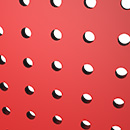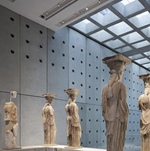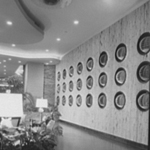
Perforate
Perforate is a regular pattern of consistently shaped and spaced holes that have been cut into a material. more
Perforate | Material
application
Smaller perforations cut from metal are formed by stamping, while larger perforations require laser cutting. The nature of the sheet material varies considerably simply by changing the size and concentration of perforations.
research
Traditional Islamic artists and craftsmen decorated surfaces of everything from modest artifacts to monumental architecture with elaborate geometric patterns. The Koran forbids the representation of people and animals, but this in no way hinders creativity.1 Artisans generate intricate patterns by combining, duplicating, and interlacing simple shapes, commonly the circle and square. The seemingly infinite geometries surprise and delight the senses, especially as architectural screens. As screens, patterns become even more complex, interacting with vistas and manipulating light and shadow.
In India, this window treatment is called jali, and has become a salient feature of the country’s architecture. Hand-carved out of a single slab of stone, the geometric mesh of jali responds to a number of cultural and environmental conditions by providing privacy and security, filtering light, and permitting the circulation of air. The fretwork also works as a unifying element in architecture, an approach Herbert J.M. Ypma describes as "ornate order." The jali colonnade at Akbar's tomb may at first appear to follow a strict geometric pattern; in reality, the total design is actually random, with each screen containing a unique abstract pattern. Together the screens produce a feeling of infinite growth, framed and thus contained within a series of regularly spaced, identical arches. Ympa describes the tension occurring between the free flowing detail and the repetitive structural elements as a "combination of chaos and restraint." Ympa also claims that this ordering principle of "asymmetry within symmetry" influenced renowned modernists Le Corbusier and Louis Kahn.2
European modernism influenced design in Arab countries most noticeably in major cities such as Algiers, Casablanca, and Beirut. While building facades in these cities began emphasizing the modernist principles of simplicity and functionality, the interiors still relied on traditional forms of ornamentation. Furthermore, highly skilled local craftsmen responsible for executing the designs greatly influenced the architecture. Architectural historians Jean-Louis Cohen and Monique Eleb credit the development of many Arab metropolises to both the modern designs of architects and the specialized knowledge of master carpenters, joiners, gardeners and mosaic layers.3 From this blending of external influences with traditional customs emerged a new form of architecture that Le Corbusier termed "Mediterranean Modernism."4
While these interiors often relied on traditional forms of ornamentation, those of the elite demonstrated exposure to the latest trends in modern design, especially furniture. The cultural exchange, however, was not one directional. For example, a brochure published by the Knoll furniture company in 1960 presents an unusual pairing of styles. Square-perforated screens framed by arches reminiscent of traditional Arab architecture serves as the background for an arrangement of Eero Saarinen's Tulip chairs and table. The caption reads "Morocco provides a sixteenth century setting for the modern elegance of marble, plastic and deep blue wool."5 Interestingly, the perforated screens depicted in the advertisement do not contain dynamic geometric creations, but instead have been replaced with a regular grid pattern more attuned to modernist sensibilities.
For a brief period in the 1960s Moroccan-inspired décor became fashionable and screens mimicking traditional patterns appeared in a variety of settings such as apartment lobbies and restaurants. While this misappropriation eventually became obsolete, the use of dematerialized partitions in contemporary interiors continues unabated. Such partitions share similar characteristics with the screens depicted in the 1960 Knoll publication, often utilizing a regular pattern of either a circle or square.
The character of perforated screens changes dramatically simply by varying the size and overall concentration of perforations. Highly concentrated, small perforations read like a fine mesh. The eye has difficulty determining the basic shape and boundaries of individual perforations and this sometimes creates a moiré pattern. As perforations grow in size, each shape gains greater autonomy from the whole. Now the eye can distinguish individual perforations as well as how they contribute to the overall pattern.
Perforated metal sheets are made by using a mechanical stamping process.6 Patterns made entirely from circles or squares are most common, but manufacturers do offer ornamental patterns reminiscent of Islamic art. Perforations exceeding a diameter or length of 1-1/2 inches typically require laser cutting rather than stamping. Although commonly made of metal, perforated sheets can be made from wood or plastic. For example, Stephen Holl Architects apply perforated plywood panels to the lobby walls in the Cranbrook Institute of Science. Alternatively, silk-screened patterns can be applied to glass or plastic to simulate a perforated material in reverse (holes become solid, while the solid becomes a transparent/translucent material).7
end notes
- 1) Herbert J.M. Ypma, India Modern: Traditional Forms and Contemporary Design (London: Phaidon Press Ltd., 1994), 205
- 2) Ypma, India Modern, 183; Traditional Indian jali screens carved in stone in Interior Design (Aug 1985): 232.
- 3) Mateo Kries, "From Hassan Fathy to Downtown Dubai:Arab Domestic Culture and Modernism" in Living Under the Crescent Moon: Domestic Culture in the Arab World, ed. Mateo Kries and Alexander von Vegesack (Weil am Rhein: Vitra Design Museum, 2003) 277.
- 4) Kries, Living Under the Crescent Moon, 265, 276.
- 5) Kries, Living Under the Crescent Moon, 277.
- 6) J. Rosemary Riggs, Materials & Components of Interior Architecture (Upper Saddle River, NJ: Prentice Hall, 2003), 121.
- 7) Evidence for the archetypical use and the chronological sequence of Perforate as a material was developed from the following sources: 1960 Carl Hoppl's Restaurant [1962] Egils P. Hermanovski, AID; Baldwin, NY in Anonymous, "Restaurants," Interior Design 33, no. 4 (Apr. 1962): 188; PhotoCrd: Ben Schnall / 1980 Traditional Indian Jail Screen, "Festival of India" [1986] location in Bernard Rudofsky, "Lessons from India: The Optical Distillers," Interior Design 56, no. 8 (Aug. 1985): 231; PhotoCrd: Bernard Rudofsky; Festival Naha, Okinawa [Nov. 1985] Tadao Ando Architect and Associates; Naha, Okinawa, Japan in Anonymous, "Open Market," Architectural Record 173, no. 13 (Nov. 1985): 121; PhotoCrd: Anonymous / 1990 Balcony, Unite d'Habitation [1952] Le Corbusier; Marseilles, France in Jean-Louis Cohen, Le Corbusier (Kohn: Taschen, 2004), 60; Paula Cooper Gallery [1997] Richard Gluckman; New York City in Henry Urbach, "Hall of Fame: Richard Gluckman," Interior Design 79, no. 15 (Dec. 1999): S8; PhotoCrd: Eduard Hueber; American Cinematheque [1999]; Renovation, Egyptian Theatre [1922]; Hodgetts and Fung Design Associates; Hollywood, CA in Anonymous, "American Cinematheque at the Egyptian Theatre," Interiors 158, no. 2 (Feb. 1999): 51; PhotoCrd: Randall Michelson / 2000 MOD Restaurant [2000] Suhail Design Studio; Chicago, IL in Lisa Skolnik, "Mod is in the Details," Interiors 159, no. 8 (Aug. 2000): 68; PhotoCrd: Douglas Fogelson; Cabots [2001] Thom Faulders, Beige Design; San Francisco in Aaron Betsky, "Tangerine Dream," Interiors 160, no. 5 (May 2001): 114; PhotoCrd: H. Masubuchi/Beige Design; Lotus Club [2001] Nancy Mah and Scott Kester, Nancy Mah Design; New York City in Pilar Guzman, "Eat, Drink, Man, Woman," Interiors 160, no. 3 (Mar. 2001): 88; PhotoCrd: Nancy Mah Design; Simmons Hall Dormitory, MIT [2003] Stephen Holl; Cambridge, MA in Sarah Amelar, "Steven Holl Experiments," Architectural Record 191, no. 5 (May 2003): 213; PhotoCrd: Paul Warchol; Frisson Restaurant [2005] Scott Kester; San Francisco in Zahid Sardar, "Bon Voyage," Interior Design 76, no. 2 (Feb. 2005): 172; PhotoCrd: David Wakely; REHAB [2005] Herzog & De Meuron; Basel, Switzerland in Suzanne Stephens, "REHAB, Center for Spinal Cord and Brain Injuries," Architectural Record 193, no. 6 (June 2005): 120; PhotoCrd: Margherita Spiluttini; Lobby, Hotel Puerta América [2005] Kathryn Findley, Architect and Jason Bruges, Designer; Renovation, Hotel [1945] Jean Nouvel; Madrid, Spain in David Cohn, "Overnight Sensations," Architectural Record 193, no. 9 (Sep. 2005): 101; Modern Restaurant, Museum of Modern Art [2005] Bentel & Bentel Architects; New York City in Suzanne Stephens, "The Modern," Architectural Record 193, no. 9 (Sep. 2005): 129.
bibliographic citations
1) O'Brien, Elizabeth. “Material Archetypes: Contemporary Interior Design and Theory Study.” M.A. Thesis, Cornell University, 2006, 11-19.
2) The Interior Archetypes Research and Teaching Project, Cornell University, www.intypes.cornell.edu (accessed month & date, year).


